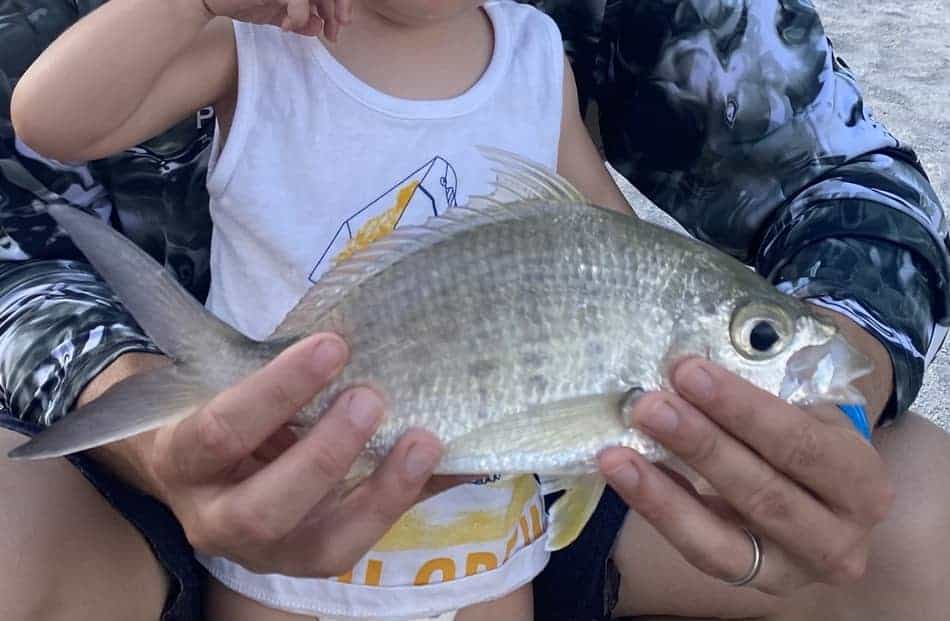
Porgy are a fun, easy fish to catch, making for a great fish to target with the entire family. Let’s take a look at how to catch Porgy by taking a closer look at the species.
How To Catch Porgy
Porgy are caught bottom fishing on shallow water structures, near sandy bottoms. You can catch them using a hi-low rig outfitted on a light fishing setup and using cut squid for bait.
Finding Your Porgy Hotspot
When it comes to catching Porgy, the first step to ensure a successful day on the water is locating a shallow structure that is believed to hold them. Porgy inhabit rock piles, reefs, wrecks, and jetties, especially when these structures are surrounded by sandy bottom. Finding the right structure is going to make or break your success in catching Porgy.
Positioning Yourself Correctly For Porgy
Once you have located a potential Porgy hotspot, the first thing to do is drop down your anchor up-current from the structure you are targeting. When your anchor is holding the bottom and your boat is positioned just up current of the structure, it’s time to get a chum block in the water. For anglers targeting Porgy from shore, try to position yourself up current from the structure you are targeting the fish.
Properly Chumming The Water For Porgy
Chumming the waters for Porgy is slightly different than the typical manner you would chum for fish. Porgy becomes most active when your chum block is lowered to the lower third of the water column. As many anglers already know, chum itself typically floats, so to get your chum block down to the bottom, you will have to come prepared. The best way to get your chum to the bottom is to use a weighted chum bucket or tie a 1lb+ sinker to your chum bag.
Getting Your Porgy Rig To The Bottom
After the anchor is set and the water is chummed, it’s time to get your lines in the water. As mentioned earlier, Porgy are bottom-dwelling fish, so your fishing rig must make it to the bottom and stay there. Since Porgy are rarely caught in waters exceeding 60′ in-depth, using a 2 to 3-ounce sinker is ideal.
Choosing The Right Rig To Catch Porgy
Most anglers catch Porgy using a hi-low rig or knocker rig. The hi-low rig is essentially a series of hooks tied to your leader, all weighed down with a single weight at the bottom. The knocker rig is simply a sliding egg sinker that slides up and down the line. No matter which rig you use, there is a good chance you will have success catching Porgy if you can find a large school.
Choosing The Best Porgy Bait
The best bait we have found to catch Porgy is small cut-up pieces of squid measuring less than an inch in diameter. Porgy have small mouths and nibble at their food as they eat, so use a bait that holds firmly to the hook, like squid, or you’ll be spending most of your day rebating your hook.
Mark Your Porgy Honey Hole
Once you have located where the school is congregating, mark your GPS coordinates so you won’t lose track of your spot as the current and wind conditions change and move you around. Also, marking the GPS location will give you a hotspot to return to another day when searching for Porgy.
If you are not getting any bites within 10 minutes or so, it’s probably best to try another spot.
Expert Tips On Catching Porgy
- Bring out the clam chum: When it comes to catching Porgy, using the correct type of chum is an absolute must. If you can, make your own or find a tackle shop that carries clam chum. Next to clam chum, your second-best option is to use an extra-fine menhaden chum.
- Find the sand pockets: Porgy congregate around shallow water structures, especially when adjacent to large sand pockets. If you can locate a reef surrounded by pockets of sand, you can be confident you are in Porgy country!
- Fish down current of the structure: Since Porgy are small fish that live in the open ocean, they use structures to shield themselves from heavy moving currents. Fish slightly up-current of the structure you are targeting; hopefully, your bait will drift by a large school of Porgy who are waiting for the current to bring dinner their way.
- Check the water temperature: The Porgy bite significantly slows down as water temperatures decrease. If the water temperature in the area you are fishing drops below 55 degrees Fahrenheit, it’s probably best to target another species until temperatures rise.
- Light tackle is key: Using light tackle is a must when targeting Porgy. Porgy have excellent eyesight and are frequently caught in clean waters, so using light tackle is ideal so they don’t see your tackle.
- Early bird gets the Porgy: Although they are caught throughout the day, they are most active during the early morning.
- Fish the grass flat ledges: If you are just looking to have some family fun catching Porgy and are not particular about catching keepers, it is easy to catch a lot of small porgy fishing grass flat ledges with Mirco fishing tackle.
When polled, 93% of Florida Fishing Captains stated that the most productive fishing depth to catch Porgy was between 20′ and 30′ of water.
Independent Poll by Fishinvestigator.com
Top Baits For Porgy
- Clams
- Mussels
- Squid
- Shrimp
- Sand Fleas
Using Artificial Lures For Porgy
Though you will have the most success fishing with fresh-cut bait, sometimes that is not possible. If this happens to be the case using small scented lures will be the ideal solution.
Here are a couple of artificial lures that may come in handy next time you can’t get bait.
- Gulp! Minnow Grub
- Gulp! Sand Crab Flea
- Fish Bites
When Can You Catch Porgy
Porgy are caught year-round but are most prevalent in the summer months, particularly May and June. The best time to catch them is early morning, however, they are known to feed throughout the day.
Where Do You Catch Porgy
Porgy are caught fishing shallow water structures in 15′ to 60′ of water in tropical, subtropical, and temperature climates. Porgy congregate heavily around reefs, wrecks, piers, and jetties, especially in areas with a sandy bottom.
Best Fishing Spots for Porgy
- Wrecks
- Piers
- Docks
- Grass flat ledges
- Jetties
Best Fishing Tackle For Catching Porgy
Catching Porgy can be a simple fishing adventure if you come prepared with the correct fishing tackle. Below are my recommendations for the best tackle to use to catch lots of Porgy.
Best Fishing Rod For Porgy
Porgy are not known for their size or fighting ability, so choosing a light rod is ideal for keeping the sport of catching them. An excellent rod option for catching Porgy is the Triumph, a 6’6 medium-light, fast-action spinning rod by St.Croix.
Best Fishing Reel For Porgy
The best reel size for catching Porgy is 2000 to 3000. Porgy are not strong fighters, nor are they targeted in deep waters, so almost any reel will do the job in retrieving these fish. If you are targeting a larger Porgy or using a hi-low rig, you may want to increase your reel size to a 3000 to handle the possibility of hooking multiple fish at once. Check out Penn’s Battle series if you are looking for a great reel that will not break the bank.
Best Line To Use For Porgy
The best line for fishing for Porgy is a 15lb to 20b braid, preferably with abrasion resistance in mind since you will be fishing for them near underwater structures. One great line option is Power Pro’s Super Slick V2.
What size Leader To Use For Porgy?
The best leader to use for Porgy is a 15lb Fluorocarbon leader.
What Size Hooks For Porgy?
Porgy have small mouths, so an ideal hook size for catching them is a #4.
Let’s take a deeper look at how to catch Porgy by learning more about the species as a whole.
What are Porgy
Sparidae, commonly referred to by anglers as Porgies, Scub and Sea Bream are small fish that inhabit the shallows in tropical, subtropical, and temperate waters. Porgy are characterized by their small whitish silver bodies and hunched backs. Porgy are carnivorous bottom-dwellers spending most of their time hunting for their next meal.
Natural Porgy diet
- Worms
- Mollusk
- Squid
- Sand Fleas
- Sand Dollars
- Baitfish (varying species)
Are Porgy Good To Eat?
Porgy are excellent to eat. The flesh of the fish is white and flaky, with a mild flavor profile often compared to snapper. Porgy rarely exceed 2lbs in weight, so if you are interested in eating them, it is recommended to harvest multiple to make a complete meal.
Is Porgy High In Mercury?
Porgy are extremely low in mercury content, coming in at .08 PPM. To put that into perspective, that is 1/5th the mercury levels found in the commonly consumed Snook.
Is Porgy Toxic?
Although most Porgy species are not toxic, one species, the Salema Porgy, is known to be toxic. The Salema Porgy is known to carry a toxin that creates LSD-like hallucinations when consumed.
Are Porgy In The Same Family As Mojarra?
Although the Porgy and Mojarra share many physical characteristics, they are not in the same family. Porgy are in the Sparidae family, whereas Mojarra is in the Gerreidae family.
Do Porgy Have Scales?
Porgy have scales that start from their gill plate and end at the base of their tails. Porgies scales are large for their overall body size, typically measuring a quarter inch in size for mature adults.
Do Porgy Have Teeth?
Porgy have both small canonical teeth and pharyngeal teeth. Their canonical teeth are found on the top and bottom jaws of the fish, and their pharyngeal teeth are found at the back of their throats and are used for crushing mollusk and other hard sea creatures.
Porgy Size & Bag Limit
| State | Length | Bag Limit |
| Florida | 8″ | 50 |
| Georgia | 14″ | 3 |
| South Carolina | 16″ | 5 |
| Virginia | 8″ | 30 |
| Massachusetts | 9″ | 30 |
